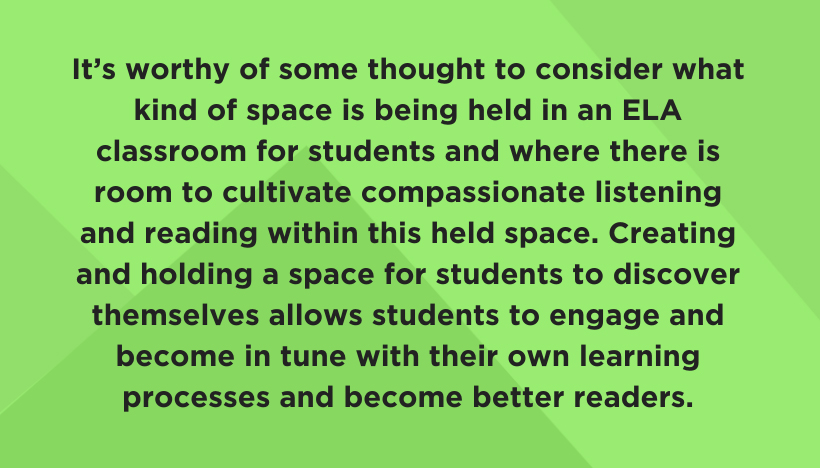This post was written by NCTE member Adam Mackie.
The Miracle of Reading
On, between, beyond & through the lines
On the same spot I sit today
Others came, in ages past, to sit.
One thousand years, still others will come.
Who is the singer, and who the listener?
—Nguyen Cong Tru
In high school, when I was the age of the students I teach, I remember going to the public library and discovering Thich Nhat Hanh’s The Miracle of Mindfulness (1975). I was forever changed.
Like Gandhi, Mother Theresa, Martin Luther King Jr., and others, Thich Nhat Hanh has offered a longstanding voice of peace, love, nonviolence, and compassion to the world. His writings continue to help me to slow down, to not be in such a rush to wash the dishes or peel a tangerine, and to guide my heart and mind to begin seeing life in a mindful way. Thich Nhat Hanh’s teachings have encouraged me to listen with compassion, a way of listening he discusses in a 2010 interview with Oprah Winfrey.
As I teach English language arts (ELA) at West Anchorage High School in Alaska, it’s my continual task, among so many others, to teach students to use the kind of mindfulness and compassionate listening Thich Nhat Hanh teaches in an effort to closely, critically, and, perhaps most important, compassionately read. As I grow as an ELA teacher, I’ve realized that for students to learn to read I must continue to use tried-and-true reading and annotation strategies.
One annotation strategy I use is the double-entry log (organizing quotes and paraphrases in one column and metacognitive responses in another). With much success, I’ve used the double-entry log both as a student and as a teacher. I’ve seen the double-entry log assist readers at all levels to read, as it’s sometimes said, on, between, and beyond the lines of a text effectively.
I’ve found other strategies and approaches as well. Over my years of teaching, I’ve turned to Reading for Understanding: How Reading Apprenticeship Improves Disciplinary Learning in Secondary and College Classrooms (Greenleaf, Murphy, and Schoenbach, 2012), Teaching in the Connected Learning Classroom (Ed. Garcia, 2014), and A Writer’s Guide to Mindful Reading (Carillo, 2017), to name a few.
Most recently, I’ve relied on the Reading for Understanding book to help readers with emerging literacy skills in a Reading Apprenticeship course find personal connections in what they are reading and identify reading roadblocks inside themselves. I must also mention the significance of sharing my personal passion for literature with students in hopes that students might become more compassionate toward ELA as a discipline.
Beginning from a place of passion and enthusiasm, I aim to help struggling and advanced readers alike identify their own reading roadblocks and more skillfully realize who they themselves are on a deeper level.
This helps students understand facts about themselves as readers that might be holding their literacy back from real growth and evolution. Roadblocks typically involve vocabulary or connotations of meaning beyond students’ life experience that prevent them from denoting and comprehending what a text is trying to communicate (reading on the lines).
From here, of course, readers go further and formulate their own inferences and understanding (reading between the lines). Once close reading of a text has been performed, and critical analysis begins, I attempt to point students to connect what they read to their own worlds. I also point students to explore inroads into other supplemental texts in a synthetic fashion (reading beyond the lines). However, I’ve noticed that something is often missing. No matter if students decode, or even analyze and synthesize a text, students still need to begin from a position of compassion to enter into reading on a more personal, genuine level.
Deeply encountering a text through the lines of compassion bridges the gap for students between the head and the heart and between reason and emotion. In bridging this gap, I see the necessity of exercising compassion to create a consciousness capable of reading through the lines. While reading on, between, and beyond the lines continues to be of vital importance, I further aver that reading compassionately through the lines—whether determining denotative or connotative meaning—is paramount and that there is a myriad of beautiful ways to arrive at this kind of reading in ELA classrooms and across the disciplines.
Holding Space
Staying in touch with ourselves and others
Attachment to the false view of self means belief in the presence of unchanging entities
which exist on their own. To break through this false view is to be liberated from every
sort of fear, pain, and anxiety.
—Thich Nhat Hanh
A friend who is a local yoga instructor talks a lot about “holding space” for her clients in her yoga nidra sessions. I once told her that “holding space” in the classroom, as an educator, is what I attempt to do for students as well.
It’s worthy of some thought to consider what kind of space is being held in an ELA classroom for students and where there is room to cultivate compassionate listening and reading within this held space. Creating and holding a space for students to discover themselves allows students to engage and become in tune with their own learning processes and become better readers.
Space can be held in the classroom in a variety of ways. I start every class by giving students the opportunity to share “good things” (or bad things) as a way to check in on how everyone is doing. I’ll often begin classes with a moment of silence or a guided writing prompt that points students inward to explore their private thinking. Norman Fischer’s Sailing Home: Using the Wisdom of Homer’s Odyssey to Navigate Life’s Perils (2011) is an excellent resource I’ve used to teach The Odyssey. Activities from Fischer’s text are designed for participants to actively use their imaginations to visualize the ocean, homecoming, and how to treat others, and allows students to hold space within themselves, as their own audience.
Holding space can even be as simple as giving students the freedom to investigate their inner character and landscape within the held space of a mandala-like circle drawn on a blank sheet of paper.
Thich Nhat Hanh talks about tiep, a word relevant to this discussion of compassion, which literally means “to be in touch.” In his Essential Writings (2001), Thich Nhat Hanh says:
In modern society most of us don’t want to be in touch with ourselves. We want to be in touch with other things like religion, sports, politics, a book—we want to forget ourselves. Any time we have leisure, we want to invite something else to enter us, opening ourselves to the television and telling the television to come and colonize us. So first of all, “in touch” means in touch with oneself in order to find out the source of wisdom, understanding, and compassion in each of us.
Another meaning within the word tiep, according to Thich Nhat Hanh, involves being “in touch” with others. In order for me to effectively teach students how to read compassionately, I have to simultaneously be in touch with myself and my students. Likewise, my students must be in touch with themselves, with other students, with me, and with the learning objective all at the same time. One way I’ve been able to hold space in my classroom for students in this way is to open the space for them to share their cultural background in class as we explore challenging themes and motifs in the literature we read as a community.
In teaching students to read closely, critically, and compassionately, I strive to guide them toward becoming more in touch with themselves, other students, and the curriculum. Continuing to teach students sound reading approaches and strategies, such as the double-entry log or those included in Reading for Understanding, remains necessary. However, many students may desire more compassionate approaches in their reading. I invite others to join this conversation about compassionate reading and Thich Nhat Hanh’s teaching on mindfulness, and to share their experience. I look forward to a day when compassionate reading is second nature both to us and to our students.

Adam Mackie teaches mythology, world literature, reading, and writing courses at West Anchorage High School in Anchorage, Alaska, as well as literacies and poetry courses at the University of Alaska Anchorage. He loves going on epic adventures with his two children, Noah and Hazel, and his wife, Margaret.
It is the policy of NCTE in all publications, including the Literacy & NCTE blog, to provide a forum for the open discussion of ideas concerning the content and the teaching of English and the language arts. Publicity accorded to any particular point of view does not imply endorsement by the Executive Committee, the Board of Directors, the staff, or the membership at large, except in announcements of policy, where such endorsement is clearly specified.

